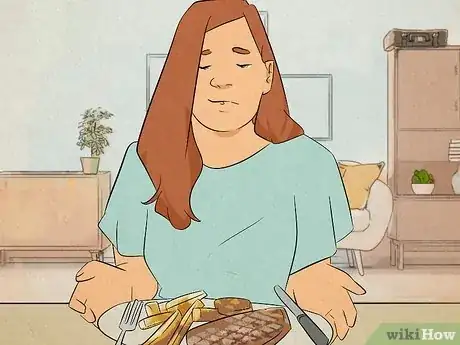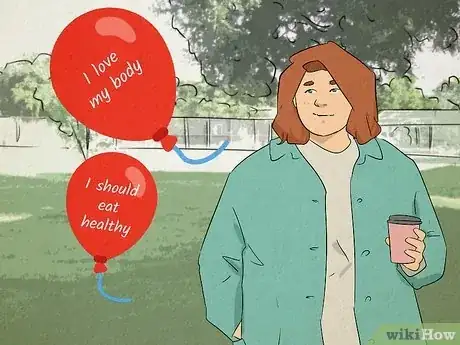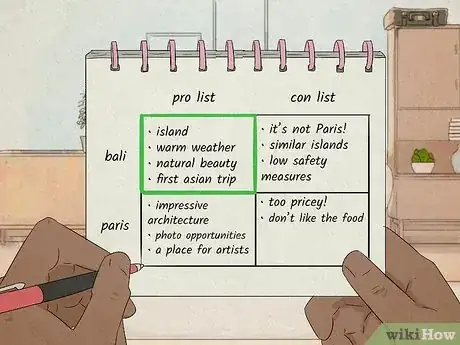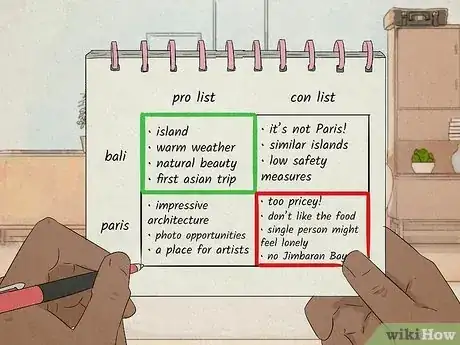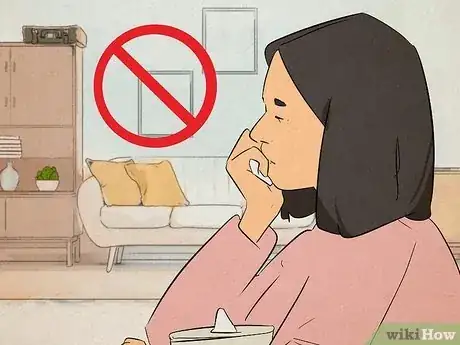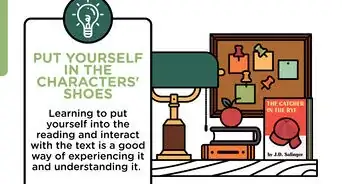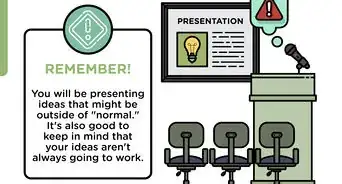This article was co-authored by wikiHow staff writer, Danielle Blinka, MA, MPA. Danielle Blinka is a Writer, Editor, Podcaster, Improv Performer, and Artist currently living in Houston, TX. She also has experience teaching English and writing to others. Danielle holds a Bachelor of Arts in English, Bachelor of Arts in Political Science, Master of Arts in English with a concentration in writing, and Master of Public Administration from Lamar University.
There are 7 references cited in this article, which can be found at the bottom of the page.
This article has been viewed 23,338 times.
Learn more...
In 1954, psychologist Leon Festinger introduced the theory of cognitive dissonance, which occurs when your actions conflict with your beliefs or you have two thoughts that don’t agree with each other. For example, you may believe eating candy every day is bad because it’s unhealthy but still continue to eat it. To resolve cognitive dissonance, you may avoid information that conflicts with your beliefs, even if it’s important to the situation, leading to bad decisions in the future.[1] To overcome cognitive dissonance, you can change your actions, challenge your conflicting beliefs, and learn how to accept hard decisions.
Steps
Changing Your Actions
-
1Identify your values. It's important to understand what you value most before you try to change your actions. It's possible that society or the people in your life may be pushing you to act in a way that goes against your closely-held beliefs, which will often result in cognitive dissonance. When you understand your values, you can better understand the reasons behind your actions.[2] Ask yourself these questions to help identify your values, then rank them in order of importance:[3]
- When have I been at my happiest?
- When in my life have I been proud of myself? What did I do to make myself proud?
- What makes me feel satisfied or fulfilled? When in my life have I felt this way, and what was I doing then?
- What makes me feel happy, proud, and fulfilled at the same time?
-
2Admit your failings. Being honest with yourself and others about when you haven’t lived up to your own expectations can help you feel better. It’s also the first step to correcting the issue. Acknowledge your slip, forgive yourself, and commit to moving forward with a clean slate.[4]
- You could say, “I’ve been feeling bad about eating meat for awhile because I think it’s wrong. I also know it’s hard to change, so I’m not going to keep feeling bad about it.”
Advertisement -
3Ask for support, if necessary. Support can come in two ways. You could ask the people close to you to accept your beliefs and not challenge your actions, or you could ask them to help you stay accountable, depending on the situation.[5] However, remember that you alone are responsible for your actions.[6]
- For example, you may ask your family to stop offering you meat dishes and to avoid pressuring you to eat meat. Alternatively, you may ask a friend who is vegetarian to remind you why you stopped eating meat whenever you feel tempted.
- You may also ask people who care about you to help hold you accountable when you feel tempted. For example, you could text them when you're tempted, asking for reminders to stay on track.
-
4Take action on your beliefs, if you can. This eliminates the conflict in your mind. If your cognitive dissonance is caused by not living in accordance with your own deeply held convictions, acting on your beliefs is often the easiest way to resolve it.[7] However, it can also be hard if your ideals are lofty.[8]
- Start with a small step toward your ideals. Even incremental change can help resolve the tension inside yourself.
- For example, if you believe that eating animals is wrong, you could stop eating meat. If this is hard, try going vegetarian for 1 day a week, then slowly increase the number of veg days.
- It takes 66 days for new behaviors to become a habit, so stick with it![9]
-
5Examine why you find it hard to live according to your beliefs, if you’re not. In some cases, you may find it difficult to live in accordance to your beliefs. There are many reasons for this, such as social pressure, personal desires, or conflicting ideals. In some cases, you may decide that it’s better to change your beliefs.[10]
- For example, you may find it hard to stop eating meat because you enjoy it. In this case, you may decide it’s a good idea to work on changing your beliefs.
Challenging Your Beliefs
-
1Accept that you will sometimes be wrong. You may be struggling with cognitive dissonance because you don’t want to accept that you were wrong. This is normal! It’s okay to change your mind, even about a deeply held belief.[11]
- If you refuse to confront potentially wrong beliefs, then they will hurt you in the long run. It's better to work through them when you first encounter information that contradicts what you believe. Remind yourself that no one is perfect. You don’t have to be right all of the time.
- You may decide to change your beliefs when changing your actions is not successful.
-
2Identify the conflict. Which of your beliefs are you violating? Figure out what behaviors are causing you to feel conflicted, then trace them back to your thoughts.[12] This helps you identify the beliefs that are causing you distress.[13]
- For example, you may think that you need to lose weight but find it difficult to do so. Your conflict could be that you believe an extreme diet is necessary, yet continue to eat larger portions.
-
3Determine why the behavior you can’t change is important to you. The beliefs that are causing your conflict could be shaped by society or others in your life. When this happens, you may find it harder to take action on the beliefs. In other cases, they may be outweighed by your desire to do the behaviors that are in conflict with the belief.[14]
- In the example above, you may think that you need to lose weight because you think it’s necessary to be accepted by others. Your diet may be hard to follow because the core belief is shaped by society, not you.
- Alternatively, you may decide that your diet is hard to follow because you have low energy on the diet, cannot enjoy shared meals with friends and family, and don’t want to give up your favorite foods.
-
4Learn more about both sides of the conflict. This helps you make informed choices about your beliefs and behaviors. In some cases, it may even give you the confidence to make a change. Alternatively, you may learn new information that supports how you already think.
- As an example, you may learn more about weight loss, optimal weight, and healthy living if you're worried about your weight.
- In some cases, people choose to resolve their cognitive dissonance by focusing only on evidence that supports their beliefs, even if it's not from trusted sources. This is caused confirmation bias and often leads to poor decisions since you aren't considering all of the facts. For example, you may believe that a particular herbal supplement can cure a condition, despite a lack of scientific proof. Reading only articles on blogs about the supposed benefits of the supplement will confirm your beliefs, even if they're incorrect. Reading the science on the supplement will help you choose a better treatment.[15]
-
5Write down reasons why the behavior you want to stop is acceptable. This helps you challenge the original belief and reduce its value.[16] The conflicting behavior becomes more valuable, allowing you to overcome the discomfort caused by the cognitive dissonance.[17]
- For example, you could focus on the positive aspects of eating more than your restrictive diet allows, such as having more energy, having a good time with friends or family, and enjoying the foods you love.
-
6Reframe your beliefs to support the behavior you want to keep. You don’t necessary need to eliminate the conflicting belief. Instead, identify it as lower than a belief that supports your behavior. You are then able to avoid feeling conflicted because the belief that supports your behavior is more important than the one that doesn’t.[18]
- In the example above, you might embrace the body love campaign, as well as the idea of seizing the day. This will allow you to act on your desires to eat what you’d like and enjoy your time with friends without feeling bad about yourself. You can still acknowledge that society may encourage maintaining a low body weight.
- Think of your beliefs as balloons. Try to inflate the beliefs you want to take priority in your life, while the others slowly deflate. Some beliefs may never go away, but they won't be as important in your life as others are.
-
7Avoid people who frequently challenge beliefs you don’t want to change. It’s normal to disagree with others, but sometimes this can cause continuous conflict. If someone is frequently pressuring you, then you may need to step back from that relationship for your own mental health. You are entitled to your beliefs.[19]
- For example, you may have a friend that constantly criticizes your food choices or puts you down. If they continue to act that way, you may decide to spend less time with them.
-
8See a therapist if feelings of cognitive dissonance persist. If addressing your actions and beliefs on your own doesn't help, it's best to talk to a therapist. They can help you identify why you're experiencing cognitive dissonance, as well as ways to alleviate it.
- For example, you may have buried thoughts that you are not addressing. Your therapist can help you uncover these thoughts and work through them.
- You can find a therapist by visiting www.psychologytoday.com or searching online. Your healthcare provider may also be able to make a referral.
Accepting a Decision
-
1Make a pro and con list. When a decision is hard, it’s important to identify the reasons why you made it. A pro and con list is a simple way to do that. This allows you to apply quantitative reasoning to your decision by adding up the pros of each alternative and weighing them against the cons.[20]
- It’s a good idea to make more than one pro and con list, especially if you’re struggling with a decision.
- For example, you may need to choose between 2 different vacation destinations, such as an island getaway or a trip to Paris. You can only choose 1, and either would be amazing.
-
2Focus on the pros for the alternative you are choosing. This helps you overcome the conflict of having to make a choice between two or more good options. Look for more positives to the alternative that you are choosing and add them to your list.[21]
- Let’s say that you decided to go to Paris because you found out a friend would be going at the same time. Rewriting your pro and con list to highlight the pros of Paris will help you avoid the conflict of choosing not to go on the island vacation.
- In this case, you might add that you will get to spend time with your friend to the pros list.
-
3Enhance the cons for the alternative you didn’t choose. This will make that option seem less appealing in your mind, allowing you to avoid regrets about missing out on it. You will be able to see the option you chose as the clear best choice.
- For example, you might add that the island getaway could result in sunburn, might be ruined by tropical weather, and could get lonely without a friend around.
- This is called “spreading” your alternatives. In effect, you are making your chosen alternative more appealing than the other option(s), which reduces your desire to question the choice.[22]
-
4Explain to someone else why you chose the alternative you did. This can help solidify that thought in yourself. Backup your choice by pointing out the pros behind the choice you made, firmly dismissing the other option(s).[23]
- For example, you could tell a friend about your decision to go to Paris, highlighting the opportunity to make memories with your friend, finally see a city you’ve always dreamed of visiting, and avoiding the dangers of a tropical disturbance.
-
5Avoid questioning the decision once it’s made. Otherwise, you’ll reawaken your feelings of cognitive dissonance. It can take time to get used to accepting your decisions without regret, especially if you’re an anxious person. However, life is full of hard decisions, and focusing on the positives of what you chose can help.[24]
- Keep your focus on the actions you're taking rather than ruminating on your decisions.
- If you do find yourself feeling discomfort or regret, work through the pro and con activity again to remind yourself that the alternative you chose is the right one.
- There’s no point in entertaining the choice you didn’t make, as you can’t go back in time. Instead, focus on the next decision you have to make.
References
- ↑ https://psychcentral.com/blog/fighting-cognitive-dissonance-the-lies-we-tell-ourselves/
- ↑ Mental Health America. Non-Profit Organization. Expert Interview.
- ↑ http://sourcesofinsight.com/finding-your-values/
- ↑ https://www.psychologytoday.com/us/blog/anger-in-the-age-entitlement/200911/better-living-through-cognitive-dissonance
- ↑ Mental Health America. Non-Profit Organization. Expert Interview.
- ↑ https://www.psychologytoday.com/us/blog/anger-in-the-age-entitlement/200911/better-living-through-cognitive-dissonance
- ↑ Mental Health America. Non-Profit Organization. Expert Interview.
- ↑ https://psychcentral.com/blog/fighting-cognitive-dissonance-the-lies-we-tell-ourselves/
- ↑ http://www.ucl.ac.uk/news/news-articles/0908/09080401
- ↑ https://psychcentral.com/blog/fighting-cognitive-dissonance-the-lies-we-tell-ourselves/
- ↑ https://psychcentral.com/blog/fighting-cognitive-dissonance-the-lies-we-tell-ourselves/
- ↑ Mental Health America. Non-Profit Organization. Expert Interview.
- ↑ https://www.simplypsychology.org/cognitive-dissonance.html
- ↑ https://www.simplypsychology.org/cognitive-dissonance.html
- ↑ https://www.simplypsychology.org/cognitive-dissonance.html
- ↑ Mental Health America. Non-Profit Organization. Expert Interview.
- ↑ https://www.simplypsychology.org/cognitive-dissonance.html
- ↑ https://www.simplypsychology.org/cognitive-dissonance.html
- ↑ http://changingminds.org/explanations/theories/cognitive_dissonance.htm
- ↑ https://psychcentral.com/blog/fighting-cognitive-dissonance-the-lies-we-tell-ourselves/
- ↑ https://www.simplypsychology.org/cognitive-dissonance.html
- ↑ https://www.simplypsychology.org/cognitive-dissonance.html
- ↑ https://www.simplypsychology.org/cognitive-dissonance.html
- ↑ https://www.simplypsychology.org/cognitive-dissonance.html





